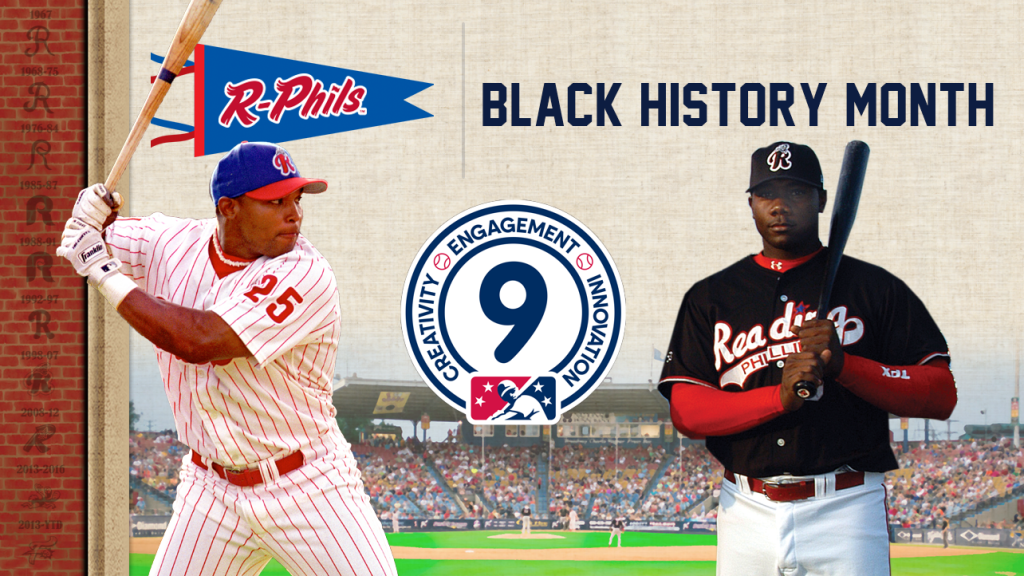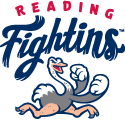
 In celebration of Black History Month, throughout February, teams across Minor League Baseball are taking a look back at five of the best Black players to suit up for their club.
In celebration of Black History Month, throughout February, teams across Minor League Baseball are taking a look back at five of the best Black players to suit up for their club.
While some of these standout performers went on to long and illustrious Major League careers, others simply had great Minor League careers or, in some cases, just one incredible season that went down as “a year for the ages.”
Here is a look at five of the best Black baseball players ever to suit up for the Reading Phillies and Fightin Phils. This is by no means a complete list of the best, just some great names to look back on.
Ryan Howard spent his entire 13-year Major League career with the Philadelphia Phillies. He was originally taken by the Phils in the 5th round in 2001. Howard, a top-ranked prospect, skyrocketed after the 2004 season when he spent the majority of his time in Reading. With the R-Phils, he batted .297 in 103 games while driving in a team-high 102 runs. He also hit 37 home runs to break the R-Phils record and was named the Eastern League MVP. He went on to hit 46 homers in total that season between Double-A, Triple-A and the Major Leagues. Nicknamed “The Big Piece”, he not only led the National League in homers (48) and RBI (146) in 2008, he also helped to lead the Phillies’ to their first World Series Championship in 28 years. The first-baseman was a three-time All-Star, was named the MVP of the NL Championship Series in 2009, and won an exciting home run derby in 2006. Howard is one of only four players, along with Cal Ripken Jr., Dustin Pedroia and Kris Bryant, to win an MVP Award (2006) the year after having won the Jackie Robinson Rookie of the Year Award (2005). The R-Phils honored Howard with an induction into the Baseballtown Hall of Fame in 2018.

Jimmy Rollins joined the farm system after being drafted in the 2nd round in 1996. Just three years later Rollins made his debut in Baseballtown, where he developed into an all-around hitter and fulltime shortstop. He recorded 145 hits, including 21 doubles, eight triples, and 11 home runs. The speedster also stole 24 bases. But most impressively, Rollins walked (51) more times than he struck out (47). Howard’s teammate on the 2008 World Series champion Phillies, Rollins took MVP honors the previous season. In a 17-season career that also included time with the Los Angeles Dodgers and Chicago White Sox, Rollins amassed 2,455 hits and 470 stolen bases. He was a three-time All-Star, four-time Gold Glove winner and still stands as the Phillies all-time hits leader. Rollins entered Reading’s Hall of Fame in 2019.

Outfielder Marlon Byrd went around the block in the Major Leagues. Originally drafted by Philadelphia in 1999, he also spent time with the Nationals, Rangers, Cubs, Red Sox, Mets, Pirates, Reds, Giants, and Indians. Byrd spent 2001 in Reading in addition to three games in 2003 as a part of a rehab stint. In an incredible campaign, he finished with a .316 batting average, leading the team in home runs (28), RBI (89), triples (8), hits (161), runs scored (108), and stolen bases (32). Rightfully so, Byrd was named the Eastern League MVP, Rookie of the Year, and post-season All-Star. He led his team to the Championship Series which was ultimately cancelled due to 9/11. The following year he was selected to the Futures Game for top prospects. In his rookie season with Philadelphia (’03), he drove in 45 runs on 150 hits. With a stellar .303 BA, he finished fourth in the Rookie of the Year voting. After a career spanning fifteen years in the majors, Byrd ended with a .275 batting average, 159 home runs, 710 runs batted in, and one All-Star game appearance.

Marlon Anderson spent a season and a half in Baseballtown and made his mark in the history books. He joined the farm system in 1995 after being drafted in the second round. In 1997, his full summer, he led the R-Phils in triples (6), hits (147), runs (88), stolen bases (27), and sac bunts (9). Anderson made an impressive debut as a Major Leaguer by hitting a pinch-hit home run. After his time with the Phillies, he also played with the Devil Rays, Cardinals, Mets, Nationals, and Dodgers. On June 11, 2005, Anderson hit an inside-the-park home run at Shea Stadium in the bottom of the ninth to tie the game. He will forever be known for his clutch hitting and utility defense.

Michael Bourn was drafted by the Phillies in the fourth round of the 2003 draft. He worked his way up the system, skipping Clearwater to join Reading in 2005 and 2006 as an outfielder. He was a fiend on the basepaths, leading the team with 68 stolen bases in 215 games. He also led in triples (’05, 8; ’06, 6), runs scored (’06, 62), and walks (’05, 63). Bourn earned the reputation as a windshield-wiper type outfielder for his ability to cover a lot of turf by throwing out 21 base runners from the outfield. After parts of two seasons with Philadelphia, he was traded with Geoff Geary and Mike Costanzo to the Houston Astros in exchange for Brad Lidge and Eric Bruntlett. Bourn also spent part of his career with the Atlanta Braves, Cleveland Indians, Arizona Diamondbacks, and Baltimore Orioles. Throughout his eleven-year career, he received two Gold Gloves, was named to the NL All-Star team twice, and was a three-time National League stolen base leader.

Like the Copa de la Diversion initiative that brought about Los Luchadores de Reading and Fiesta Friday’s, Minor League Baseball is working towards greater inclusivity with the introduction of The Nine, the first Black-centric outreach program in MiLB’s storied history. “Named for the number Jackie Robinson wore during his only season playing in MiLB with the Triple-A Montreal Royals in 1946, The Nine will connect Clubs’ local market efforts in a coordinated and centralized campaign that authentically engages and welcomes Black fans, businesses, schools, and civic leaders into MiLB’s fun-filled experiences, both in the ballpark and in the community.” The Reading Fightin Phils are a community-oriented organization that is dedicated to providing an inclusive experience for all different kinds of fans. America’s Classic Ballpark is a safe, family-friendly place to gather, celebrate, and make memories that will last a lifetime.
America’s Classic Ballpark is proud to be a part of Pennsylvania’s Americana Region and was voted the #1 stadium in all of Double-A by MiLB’s Ben Hill. Follow the R-Phils at rphils.com, on Twitter and TikTok at @ReadingFightins, on Instagram @fightins, and like them on Facebook via www.facebook.com/fightins for all information.
